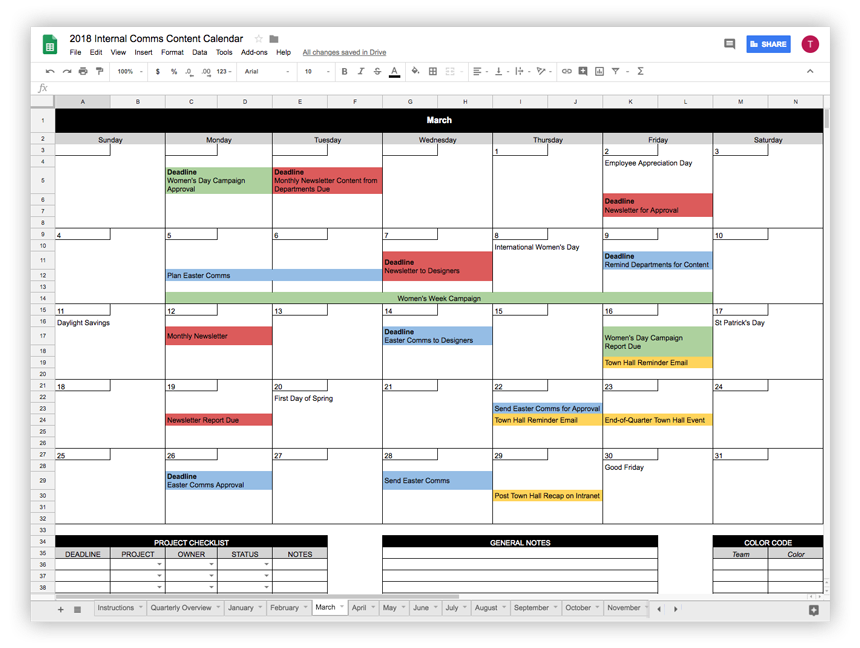
Whether it’s a new year or a new quarter, it’s never too late to start planning.
Sure, it takes focus, time, and organization—but if you put the energy into making a plan now, you’ll be reaping the rewards all year long.
Organizations are notorious for treating comms as an ‘on demand’ service. Combine that with lack of resources, long approval trees, and often not having a seat at the table, it is a struggle to do your job well, on your term, and align your efforts with your organization’s business objectives. This is why planning is a communicator’s secret weapon.
Creating an internal comms content calendar will make it all just a little (or a lot!) easier.
Why do you need an internal comms content calendar?
Adopting a content calendar will give you tangible advantages like:
- Consistency in your internal comms strategy and delivery.
- Authority by showing you have a plan and own your comms.
- Streamlined workflow by planning deadlines well in advance.
- Better collaboration among your team, leadership, and various departments.
- Organization so you can avoid running around trying to get collaborators and approval last minute.
- Respect for your processes, your role, and your timelines.
How to create a content calendar for internal comms
Step 1 – Download the template
To get started, create an excel sheet, or download our template here.
Step 2 – Add the dates that will not change
Catch up with HR and marketing to figure out which dates are not going to move. These include:
- Holidays (statutory and otherwise)
- Conferences
- Annual company events
- Annual surveys/reports
- Quarterly events

The point of adding these first is so that as you add other events and content, you can be conscious of when things absolutely have to be communicated.
Do you send out holiday communications every year and need content from various departments or stakeholders?
Pick a date for that communication now, throw in the deadlines for various contributors, and mark down when you have to have things to the design team in order to get the communication out on time.
Make sure you give yourself lots of breathing room—it is better to overestimate how long something will take rather than underestimate. Figure out how long it usually takes you to get approval for these communications, and schedule that in, too.

Step 3 – Add other events, campaigns, and launches
Touch base with department heads, stakeholders, HR, and the marketing team about campaigns, events, and launches that they are planning.
Ask for tentative dates if they don’t have anything confirmed.
This will help you stay on top of communications you could be pulled in on, well in advance. It gives you the ability to remind them beforehand that you need content, dates, or their details, instead of being pulled in at the last minute.
It is helpful to add a quarterly reminder to your calendar to check in and remind various contributors to confirm those dates and your lead time. Throw that reminder in your calendar too.
If you have to collaborate with departments/stakeholders on a particular comms initiative, figure out how much time you will need to pull it all together and plan a meeting plenty of time in advance. This will keep everyone as on schedule as possible, and keep your role top of mind.

Step 4 – Add recurring events/series
- Newsletters
- CEO addresses
- Town Halls
Do you have a monthly newsletter? A quarterly CEO address? All-hands or town hall meetings? Put in your content deadlines, reminders, and the day that all the communications need to go out into your calendar.

Step 5 – Review
This is a good time to look over what you’ve got scheduled and move things around if need be.
Too many emails at a certain time of the month? See if you can move some dates around so that you aren’t overwhelming employees.
Also make sure that you have added in reminders to yourself to remind others about deadlines, and to confirm dates. Make sure you’ve given yourself enough time to collect content, write and design the communication, and get approval before it gets sent out.
You’re in control of the calendar (for the most part), so take charge and give yourself lots of room.
Dates may change, people will forget to loop you in, things will come up, but having it all laid out will give you the chance to move things around and be more flexible when you have to.
More planning = less panic/stress.

Step 6 – Share it!
Get managers, other leadership members, and other collaborators on board by sharing the calendar around. If possible, limit their ability to edit. Give them a quick rundown on what it looks like, and implore them to work important dates and deadlines you’ve set for them into their own calendars.
If you aren’t transparent about your process it may be harder for people to remember and respect.
Naturally, there will be some finicky moving around of dates at first, but that’s okay. Think of this calendar as a living document.
Now that you’ve added a little more organization into your communications process, you can keep streamlining your workflow, figure out how long things take, and adjust accordingly to make your job and life easier, and see better results.
Step 7 – Brag!
Join the conversation below and share your secrets to success when it comes to planning your internal comms.
Have you used an internal communications content calendar before? What do you find works best? Share in the comments or tweet @Bananatag and @IABCBC
AUTHOR BIO
Kyla Sims is Bananatag’s sharp-shootin’ word-slinger, who’s got a huge crush on internal communicators. Bananatag helps communicators build beautiful, effective internal emails while helping them track and measure the success of their communications with employee email analytics. To find out more about Bananatag visit: bananatag.com/internal-comms/
Twitter: @krositabanana
LinkedIn: Kyla Sims












